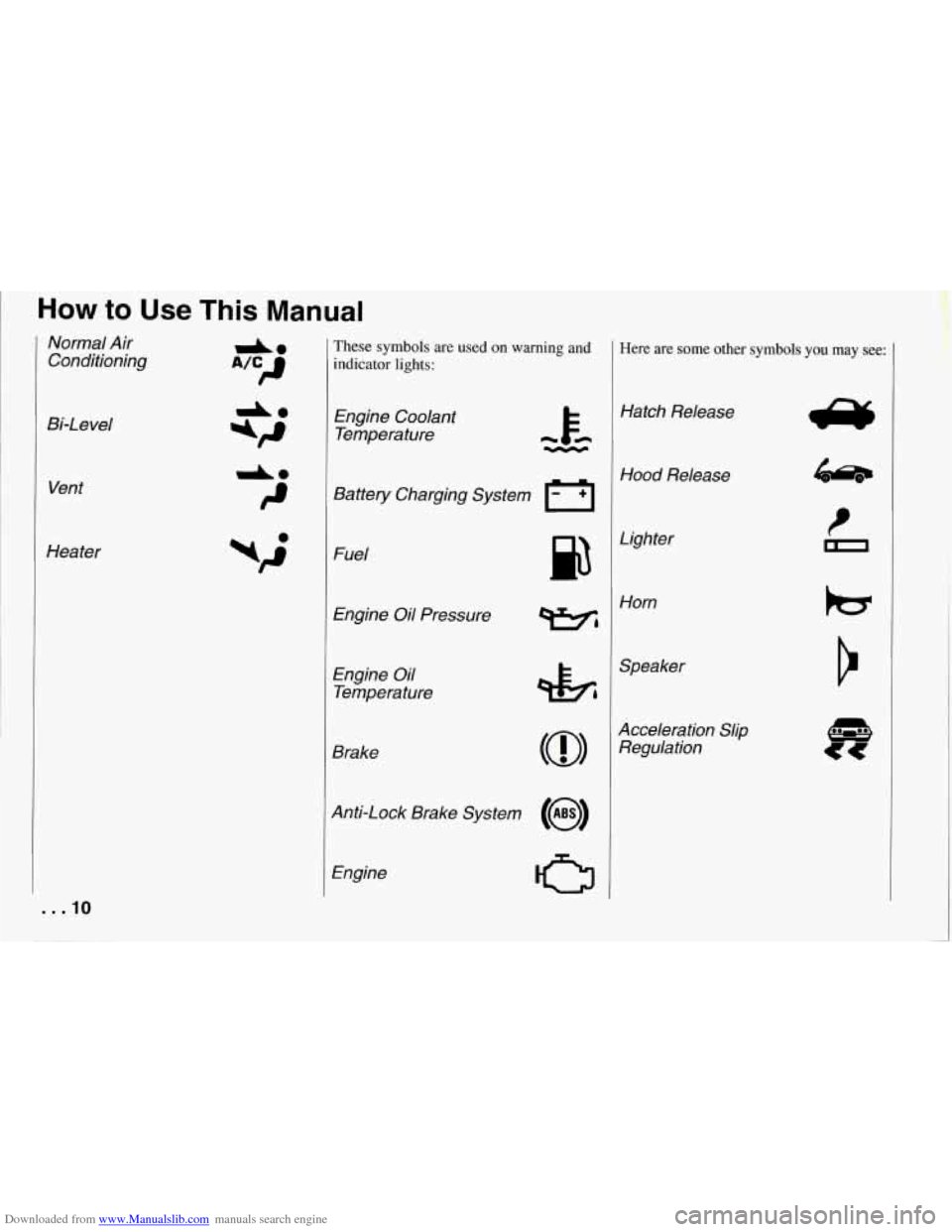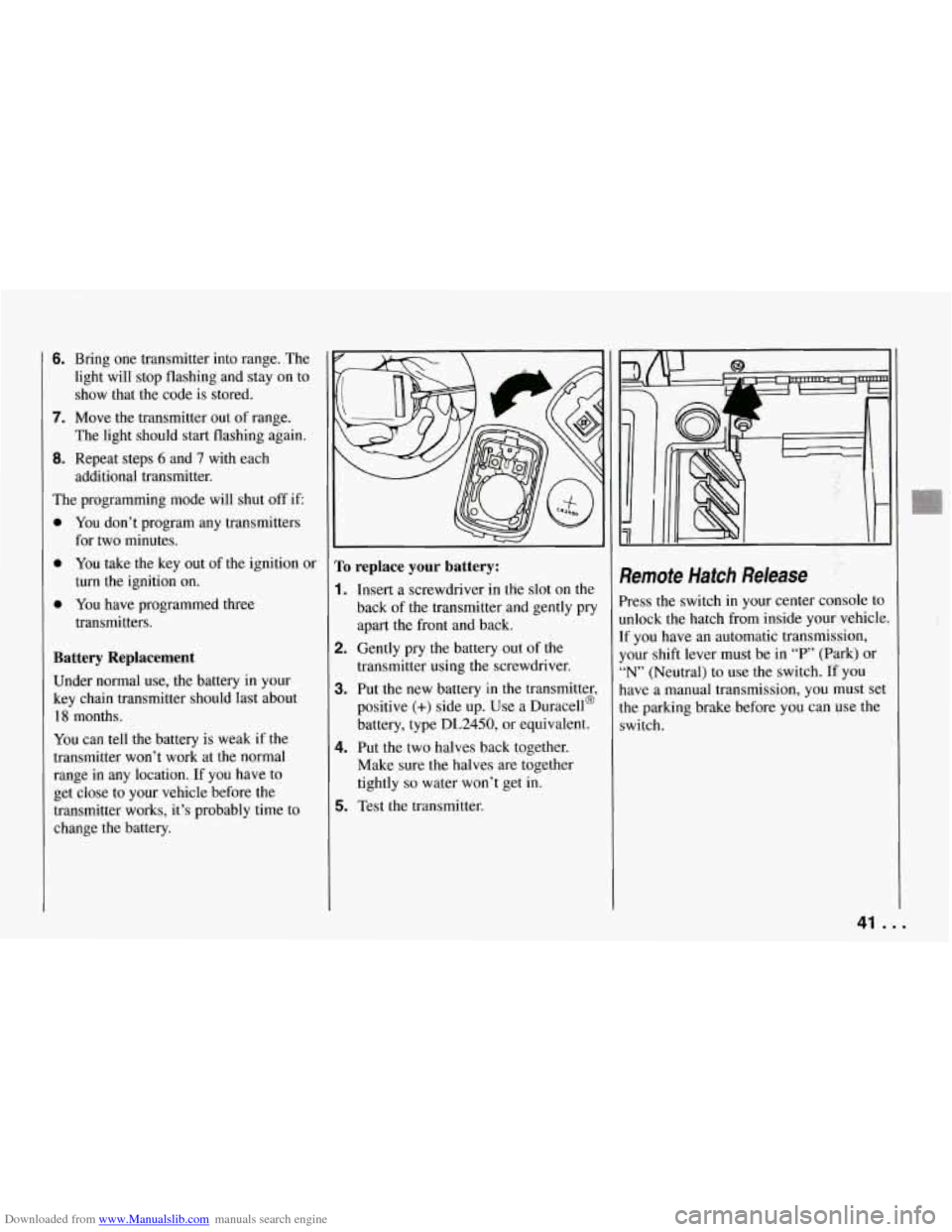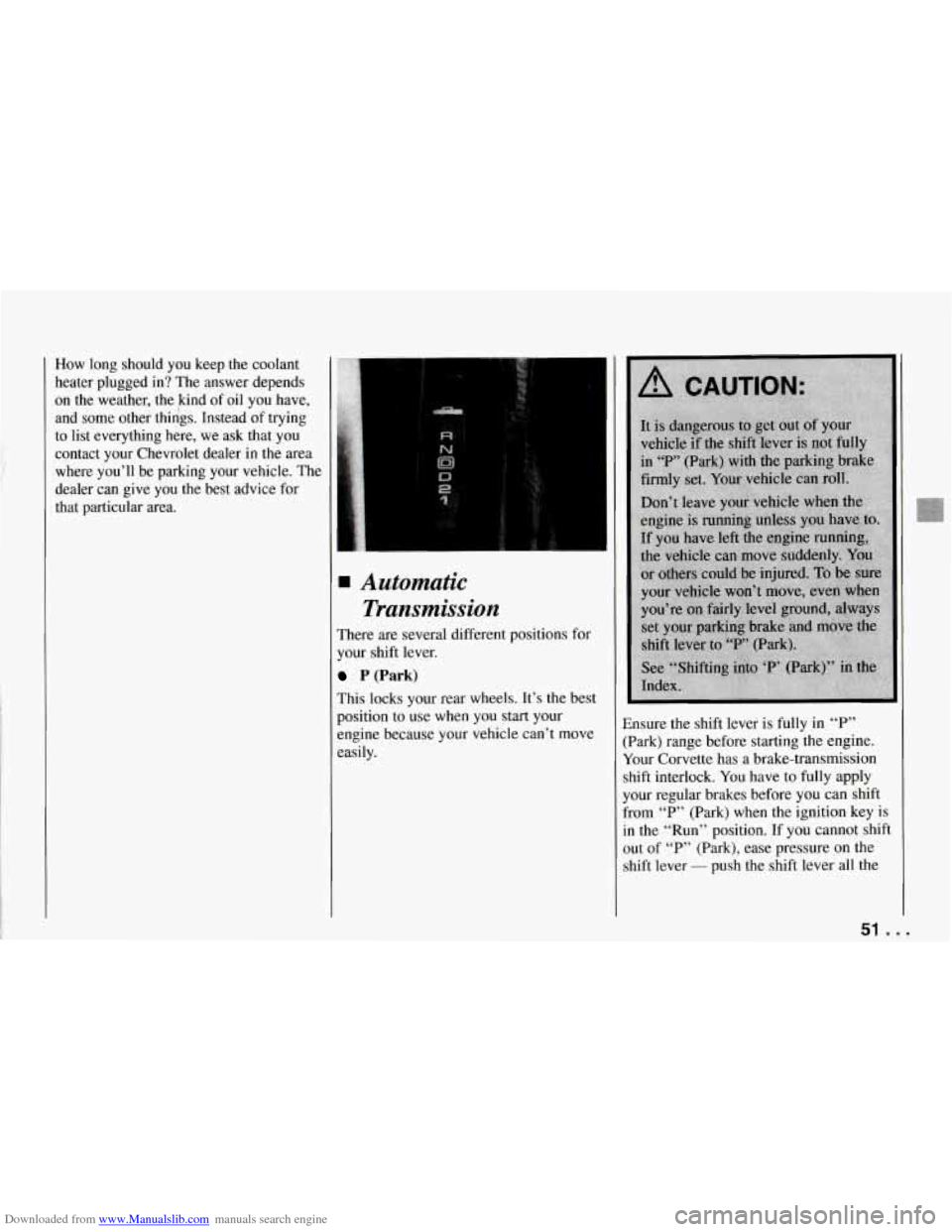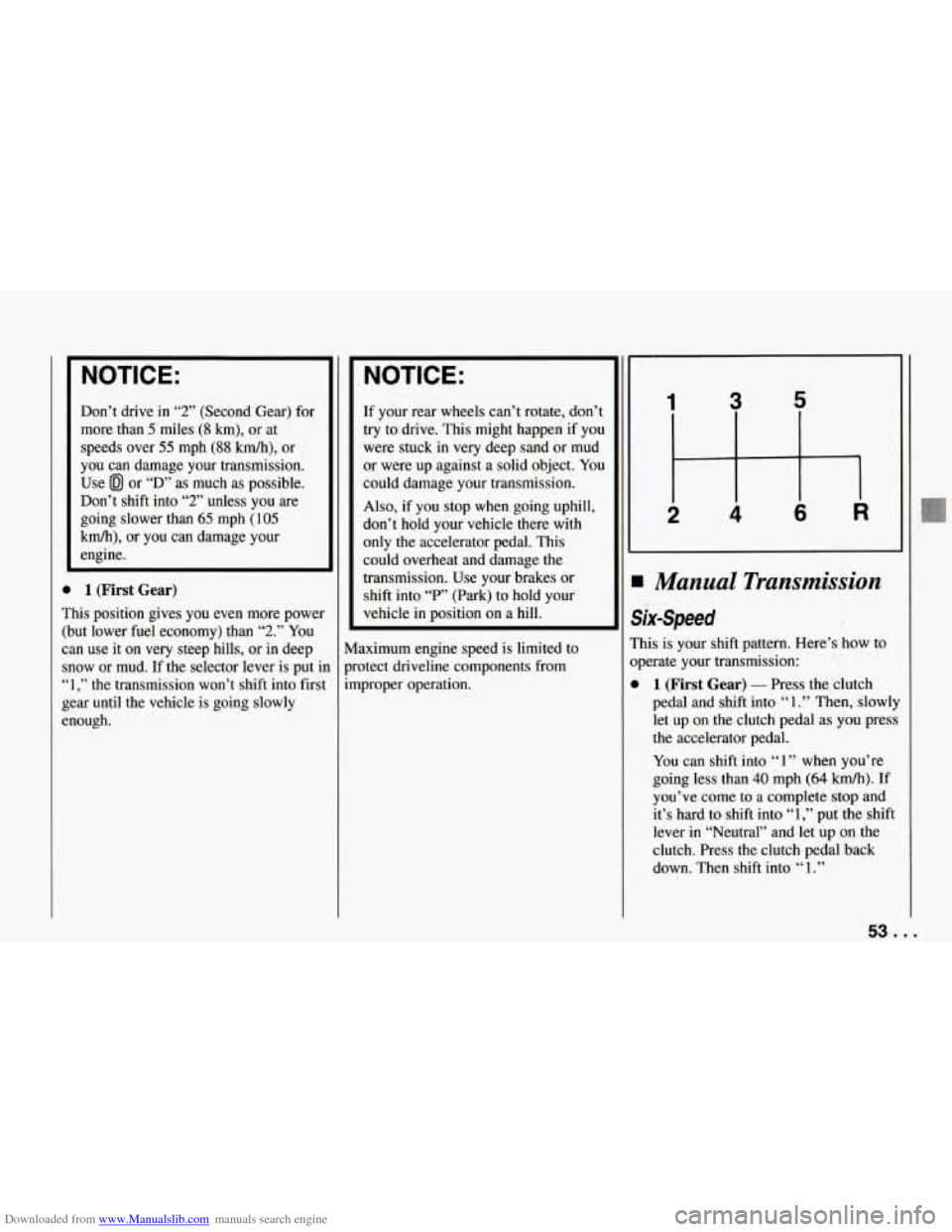1994 CHEVROLET CORVETTE brake
[x] Cancel search: brakePage 11 of 274

Downloaded from www.Manualslib.com manuals search engine How to Use This Manual
Normal Air Conditioning
Bi-Level Vent
Heater
. . .10
These symbols are used on warning and
indicator lights:
Engine Coolant Temperature
Battery Charging System
I-1
Fuel
Engine Oil Pressure
Engine Oil
Temperature
Brake
Anti-Lock Brake System
(@I
Engine
CJ
Here are some other symbols you may see:
Hatch Release
Hood Release
Lighter Horn
Speaker
Acceleration Slip Regulation
Page 42 of 274

Downloaded from www.Manualslib.com manuals search engine 6. Bring one transmitter into range. The
light will stop flashing and stay on to
show that the code is stored.
7. Move the transmitter out of range.
8. Repeat steps 6 and 7 with each
The programming mode will shut
off if:
0 You don’t program any transmitters
0 You take the key out of the ignition or
0 You have programmed three
The light should
start flashing again.
additional transmitter.
for two minutes.
turn the ignition on.
transmitters.
Battery Replacement
Under normal use, the battery in your
key chain transmitter should last about
18 months.
You can tell the battery is weak if the
transmitter won’t work at
the normal
range in any location.
If you have to
get close to your vehicle before the
transmitter works, it’s probably time to
change the battery.
ro replace your battery:
I. Insert a screwdriver in the slot on the
back
of the transmitter and gently pry
apart the front and back.
2. Gently pry the battery out of the
transmitter using the screwdriver.
3. Put the new battery in the transmitter,
positive
(+) side up. Use a Duracell@
battery, type DL2450, or equivalent.
4. Put the two halves back together.
Make sure the halves are together
tightly
so water won’t get in.
5. Test the transmitter.
?emote Hatch Release
’ress the switch in your center console to
mlock the hatch from inside your vehicle
f you have an automatic transmission,
[our shift lever must be
in “P’ (Park) or
‘N’ (Neutral) to use the switch. If you
lave a manual transmission, you must sei
he parking brake before you can use the
;witch.
..
.i ,
41 ...
Page 47 of 274

Downloaded from www.Manualslib.com manuals search engine Features and Controls
NOTICE:
Your modern Corvette doesn’t need
an elaborate “break-in.” But it will
perform better in the long run if you
follow these guidelines:
0 Keep your speed at 55 mph
(88 km/h) or less for the first
500 miles (804 km).
Don’t drive at any one speed
- fast or slow - for the
fist
500 miles (804 km).
Don’t make full-throttle
starts.
Avoid malung hard stops for
the first
200 miles (322 km)
or so. During this time your
new brake linings
aren’t yet
broken in.
Hard stops with
new linings can mean
premature wear and earlier
replacement. Follow this
“breaking-in” guideline
every time you get new
brake linings.
I
Ignition Switch
With the ignition key in the ignition
switch, you can turn the switch to five
positions:
Acc (A): Position in which you can
operate your electrical power accessories.
Press in the ignition switch as you turn
the top of it toward you.
Lock (B): The only position in which
you can remove the key. This locks your
steering wheel, ignition and automatic
transmission.
If you have an automatic transmission, tht
ignition switch can’t be turned to “Lock”
unless the shift lever
is in the “P” (Park)
position.
... 46
Off (C): Unlocks the steering wheel,
ignition and automatic transmission, but
does not send electrical power to any
accessories. Use
this position if your
vehicle must be pushed
or towed.
Run (D): Position to which the switch
returns after you start your engine and
release the switch. The switch stays in
the “Run” position when the engine is
running. But even when the engine is not
running, you can use “Run” to operate
your electrical power accessories and to
display some instrument panel warning
and indicator lights.
Start (E): Starts the engine. When the
engine
starts, release the key. The ignition
switch will return to “Run” for normal
driving.
When the engine is not running, “Acc”
and “Run” allow you to operate your
slectrical accessories, such as the radio.
A warning tone will sound if you open
the driver’s door when the ignition is in
“Off,’’ “Lock” or “Acc” and the key is in
the ignition.
Page 51 of 274

Downloaded from www.Manualslib.com manuals search engine Features and Controls
Driving through Deep Standing Water
NOTICE:
If you drive too quickly through deep
puddles or standing water, water can
come in through your engine’s air
intake and badly damage your
engine. If you can’t avoid deep
puddles or standing water, drive
through them very slowly.
Rough Idling
If you notice rough idling or surging,
especially after long periods of idling or
during slow city driving, the oxygen
sensors may be clogged. If this happens,
follow these steps to clear the oxygen
sensors:
1. Set the parking brake.
2. Shift an automatic transmission to “P”
(Park) or a manual transmission to
“N’ (Neutral).
tachometer reads
2,000 rpm and hold
for two minutes.
3. Press the accelerator until your
... 50
Engine Coolant Heater (Engine
Block Heater)
(LTI ENGINE, CANADA)
In very cold weather, 0 “F (- 18 “C) or
colder, the engine coolant heater can help.
You’ll get easier starting and better fuel
economy during engine warm-up.
Usually, the coolant heater should be
plugged in a minimum of four hours prior
to starting your vehicle.
To use the coolant heater:
1. Turn off the engine.
2. Open the hood and unwrap the
electrical cord.
3. Plug it into a normal, grounded
1 10-volt outlet.
I NOTICE:
After you’ve used the coolant heater,
be sure to store the cord as it was
before to keep it away from moving
engine parts. If you don’t, it could be
damaged.
Page 52 of 274

Downloaded from www.Manualslib.com manuals search engine How long should you keep the coolant
heater plugged in? The answer depends
on the weather, the kind of
oil you have,
and some other things. Instead of trying
to list everything here, we ask that you
contact your Chevrolet dealer in the area
where you’ll be parking your vehicle. The
dealer can give you the best advice for
that particular area.
. i:,
Automatic Transmission
There are several different positions for
your shift lever.
P (Park)
This locks your rear wheels. It’s the best
position to use when you start your
engine because your vehicle can’t move
easily. Ensure the shift
lever is fully in
“P”
(Park) range before starting the engine.
Your Corvette has a brake-transmission
shift interlock. You have to fully apply
your regular brakes before you can shift
from “P” (Park) when the ignition key is
in the “Run” position. If you cannot shift
out of
“P” (Park), ease pressure on the
shift lever
- push the shift lever all the
51 ...
Page 53 of 274

Downloaded from www.Manualslib.com manuals search engine Features and Controls
way into “P” (Park) and release the shift
lever button as you maintain brake
application. Then press the shift lever
button and move the shift lever into the
gear
you wish. See “Shifting out of ‘P’
(Park)” in the Index.
R (Reverse)
Use this gear to back up.
NOTICE:
dangerous. Unless your foot is
on the brake pedal, your
could move very rapidly.
lose control and hit
Don’t shift
out of
Shifting to “R’ (Reverse) while your
vehicle is moving forward could
damage your transmission. Shift to
“R’ only after your vehicle is
stopped.
To rock your vehicle back and forth to
get out of snow, ice or sand without
damaging your transmission, see “Stuck:
In Sand, Mud, Ice or Snow” in the Index.
N (Neutral)
In this position, your engine doesn’t
connect with the wheels. To restart when
you’re already moving, use
“N’ (Neutral:
only. Also, use
“N’ when your vehicle is
being towed.
... 52
NOTICE:
I
Damage to your transmission caused
by shifting out of “P” IPark) or
“N’
(Neutral) with the engine racing isn’t
covered by your warranty.
0 Automatic Overdrive
This position is for normal driving. If you
need more power for passing, and you’re:
- Going less than about 35 mph
(56 kmh), push your accelerator
pedal about halfway down.
- Going about 35 mph (56 km/h) or
more, push the accelerator all the way
down.
You’ll shift down to the next gear and
have more power.
D (Third Gear)
This is like 0 , but you never go into
Overdrive.
Here are some times
you might choose
“D’ instead of 0 :
- When driving on hilly, winding roads
- When going down a steep hill
2 (Second Gear)
This position gives you more power but
lower
fuel economy. You can use “2” on
hills. It can help control your speed as
you
go down steep mountain roads, but
then you would also want to use your
brakes
off and on.
Page 54 of 274

Downloaded from www.Manualslib.com manuals search engine NOTICE:
Don’t drive in “2” (Second Gear) for
more than
5 miles (8 km), or at
speeds over
55 mph (88 km/h), or
you can damage your transmission.
Use or “D” as much as possible.
Don’t shift into
“2” unless you are
going slower than
65 mph (1 05
km/h), or you can damage your
engine.
0 1 (First Gear)
This position gives you even more power
(but lower fuel economy) than
“2.” You
can use it on very steep hills, or in deep
snow or mud. If the selector lever is put
ir
“1,” the transmission won’t shift into first
gear until the vehicle is going slowly
enough.
NOTICE:
If your rear wheels can’t rotate, don’t
try to drive. This might happen if you
were stuck in very deep sand or mud
or were up against a solid object. You
could damage your transmission.
Also, if you stop when going uphill,
don’t hold your vehicle there with
only the accelerator pedal. This
could overheat and damage the
transmission. Use your brakes or
shift into
“P” (Park) to hold your
vehicle in position on a hill.
Maximum engine speed is limited to
protect driveline components from
improper operation.
1 3 5
I Manual Transmission
six-Speed
?his is your shift pattern. Here’s how to
bperate your transmission:
1 (First Gear) - Press the clutch
pedal and shift into
“ 1 .” Then, slowly
let up on the clutch pedal as
you press
the accelerator pedal.
You can shift into
‘‘ 1 ” when you’re
going less than
40 mph (64 km/h). If
you’ve come to a complete stop and
it’s hard to shift into
“1,” put the shift
lever in “Neutral” and let up on the
clutch. Press the clutch pedal back
down. Then shift into
“1.”
53 ...
Page 55 of 274

Downloaded from www.Manualslib.com manuals search engine Features and Controls
0
0
0
0
0
2 (Second Gear) - Press the clutch
pedal as you
let up on the accelerator
pedal and shift into
“2.” Then, slowly
let up on the clutch pedal as you press
the accelerator pedal.
3,4,5 and 6 (Third, Fourth, Fifth
and Sixth Gears)
- Shift into “3,”
“4,” “5” and “6” the same way you do
for
“2.” Slowly let up on the clutch
pedal as you press the accelerator
pedal.
To Stop - Let up on the accelerator
pedal and press the brake pedal. Just
before the vehicle stops, press
the
clutch pedal and the brake pedal, and
shift to “Neutral.”
Neutral - Use this position when
you start or idle your engine.
R (Reverse) - To back up, press
down the clutch pedal, and shift into
“R.” If the shift lever has a ring on it,
you have to lift the ring before you
can shift into
“R” (Reverse). If you
don’t have the ring, just apply
pressure to get the lever past
“5” and
“6” into “R” (Reverse). Let up on the
clutch pedal slowly while pressing the
accelerator pedal.
Shift Speeds (MANUAL TRANSMISSION)
This chart shows when to shift to the next higher gear for best fuel economy.
MANUAL TRANSMISSION RECOMMENDED SHIFT SPEEDS, IN MPH (km/h)
Acceleration Shift Speed
Engine
1 to2 I 2to3 I 3to4 I 4t05 I 5t06
[f your speed drops below 20 mph
(30 kmh), or if the engine is not running
smoothly, you should downshift to the
next lower gear.
You may have to
downshift two or more gears to keep the
zngine running smoothly or for good
performance.
I NOTICE:
When you are shifting gears, don’t
move the gear shift lever around
needlessly. This can damage parts of
the transmission and may require
costly repair. Just shift directly into the next appropriate gear.
... 54